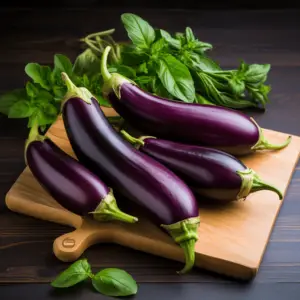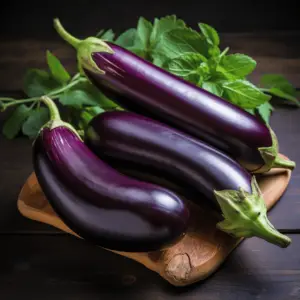Eggplant’s Potential skin is perfectly safe for consumption. In larger and older eggplants, the skin may be tougher and chewy since the eggplant loses its succulence as it gets older but it is still fine to eat.
Most people peel eggplants for this reason, but certain clever ways can soften the skin enough to eat. Younger eggplants have softer skin and don’t need peeling.
The eggplant, also known as brinjal or aubergine, is produced worldwide for its edible fruit. It may be because eggplant is a berry or fruit used in cooking, but many consider it a vegetable.
The entire fruit is edible and healthy for people and animals. The leaves and blossoms may be poisonous.
The nightshade family Solanaceae includes eggplant. Solanum melongena is its botanical name.
Nightshade plants, especially eggplant, are hazardous because their leaves and blooms contain solanine, which causes vomiting, fevers, stomach disturbances, migraines, cardiac rhythms, and death if taken in high amounts. Most cultures believed eggplants were harmful, with some saying they induced madness.
Table of Contents
Eggplant’s Potential

The misconception may have been because the leaves and flowers are the toxic portions of the plant and not the fruit.
The eggplant today is an excellent additive to food, particularly in stews and gravies. The purple and sometimes white fruit is a staple in many dishes throughout the world and makes excellent heavy dishes with many vegans even substituting it for meat owing to its earthy texture and dense bulk.
The fruit itself is rather benign in taste and can be anywhere from slightly bitter to tasteless but its constitution allows it to be an excellent ingredient in many dishes because it readily absorbs and holds flavors beautifully.
Eggplant’s Potential plain nature allows it great versatility so it can be used in any conceivable dish and even eaten raw for those who prefer the taste.
In today’s health-conscious population, eggplant has acquired a prominent position as a healthy food item to be included in your smoothie, salad, or stew.
That said, in its raw form, it has been known to trigger allergies, especially in people who are predisposed to allergic reactions.
This is not to mean that the plant is toxic but it contains a large number of substances that may irritate atopic individuals into reacting.
Cooking eggplants destroys or denatures some of the compounds in it including the high amount of histamines in it which is why cooking it would be advisable if you know yourself to be prone to allergic reactions.
Can you eat eggplant skin? Nutritional value of eggplants
Eggplants have been associated with good health and the fact that many regard them as a vegetable further advances this agenda. Eggplants are actually devoid of nutrients of any kind whether macronutrients or micronutrients.
Eggplant’s Potential value is in its versatility as an ingredient in cooking since it absorbs fats, oils, and flavors very well.
The composition of eggplant is:
- Water 92%
- Carbohydrates 6%
- Manganese 11%
- Negligible fat content
Some cultivars may have more nutrients as well as green-house varieties but generally, it is a low bulk fruit nutritionally.
The skin is a good source of fiber so if you can include it in the cooking instead of peeling then you will benefit from an increased quantity of fiber per meal.
Simple eggplant recipes to try
Deep-fried eggplant cubes
These are incredibly simple to make:
- Slice and dice two purple or white eggplants.
- Sprinkle salt on the cubes and let them sit in order to extract water and absorb the salt.
- In a skillet, pour oil about half of the way up and set it over a flame.
- Let the oil heat significantly to make the fried cubes crisp.
- Using a perforated spatula, scoop the cubes of eggplant and let the water drip.
- There is no need to dry the cubes. Just letting the excess water drain is enough.
- Place the cubes into the hot oil and let them fry for no longer than a few minutes.
- The surfaces of the cubes should begin to turn brown which means they are ready to be extracted.
- Use a spatula to remove the cooked cubes and set them aside to cool.
- Serve hot with chunks of cheese and a cold beverage.
Baked eggplants

The best eggplants for baking are actually the older bigger bulkier eggplants since they will likely absorb flavor better given the reduced succulence in their chunks.
- Wash and slice the eggplants into medium-sized pieces.
- Set them aside.
- In a bowl mix the following:
- Garlic powder
- Masala powder
- Salt
- Pepper
- Cardamom powder
- Freshly chopped parsley
- Rosemary leaves, finely chopped
- A small amount of nutmeg
- Finely chopped coriander
- Red chilies
- Black pepper
- Unflavored Greek yogurt
Baked eggplants
- The mixture above should be consistent enough to flow but not runny so use enough yogurt to achieve a fairly thick consistency.
- Pour all the eggplant slices into the mixture and let all the slices get fully immersed and coated in the mixture.
- The idea is to ensure the ingredients get absorbed as much as possible in the eggplant slices.
- Let the eggplants sit in the mixture overnight.
- Cover the bowl and store it in the fridge overnight.
- Retrieve the mixture and on a baking tray, spread some parchment paper.
- Arrange the eggplant slices over the parchment paper and place the baking tray in the oven.
- You can also use a convection microwave if you have one.
- Set the eggplants to bake for a total of about seven to ten minutes in low to medium heat.
- You should notice a fragrant scent coupled with a browning look on your eggplants which means they are beginning to caramelize.
- Do not let them burn.
- Turn off the oven and let them sit on a counter to cool.
- The baked eggplant can be served with a hot or cold beverage.


